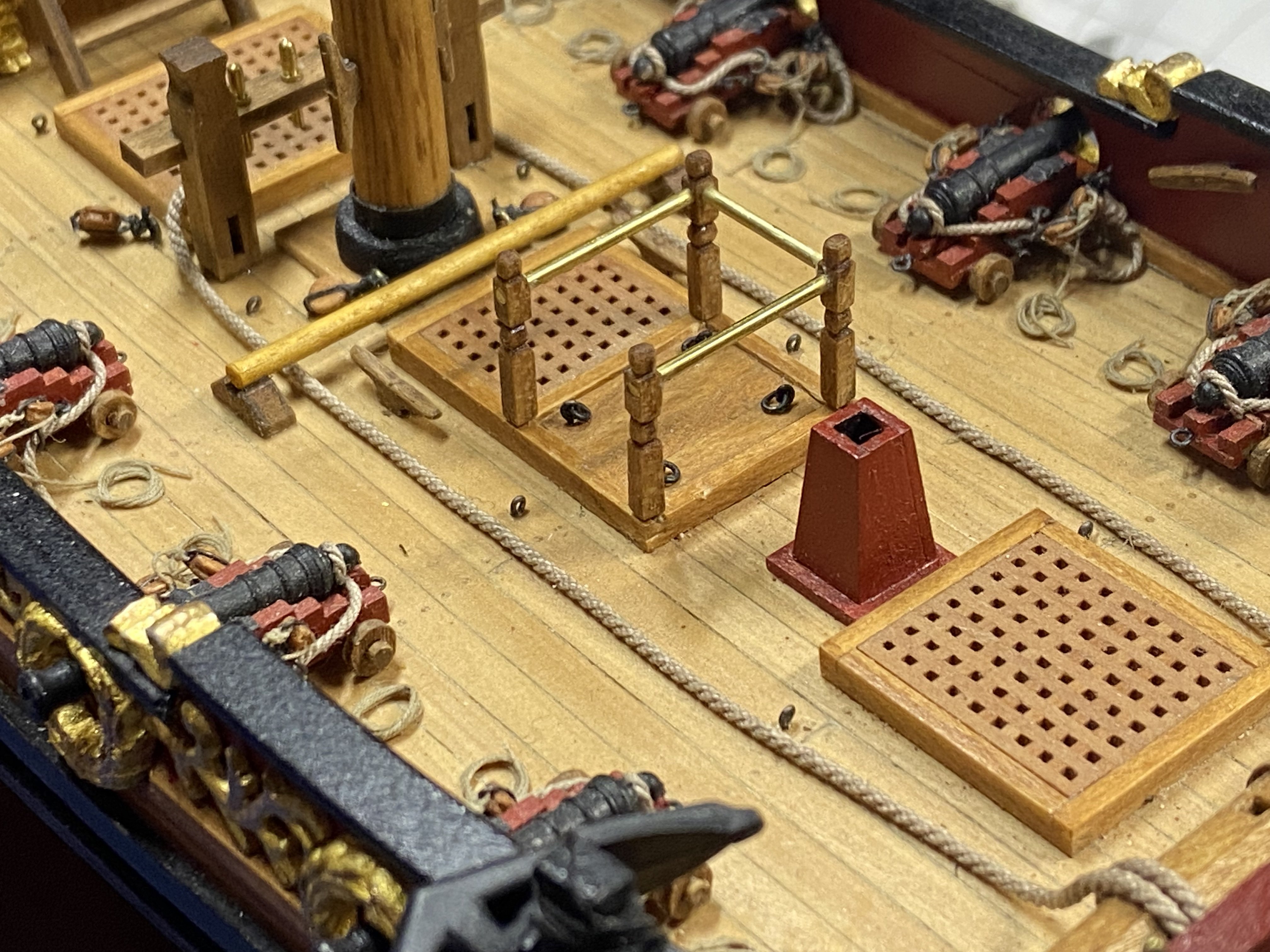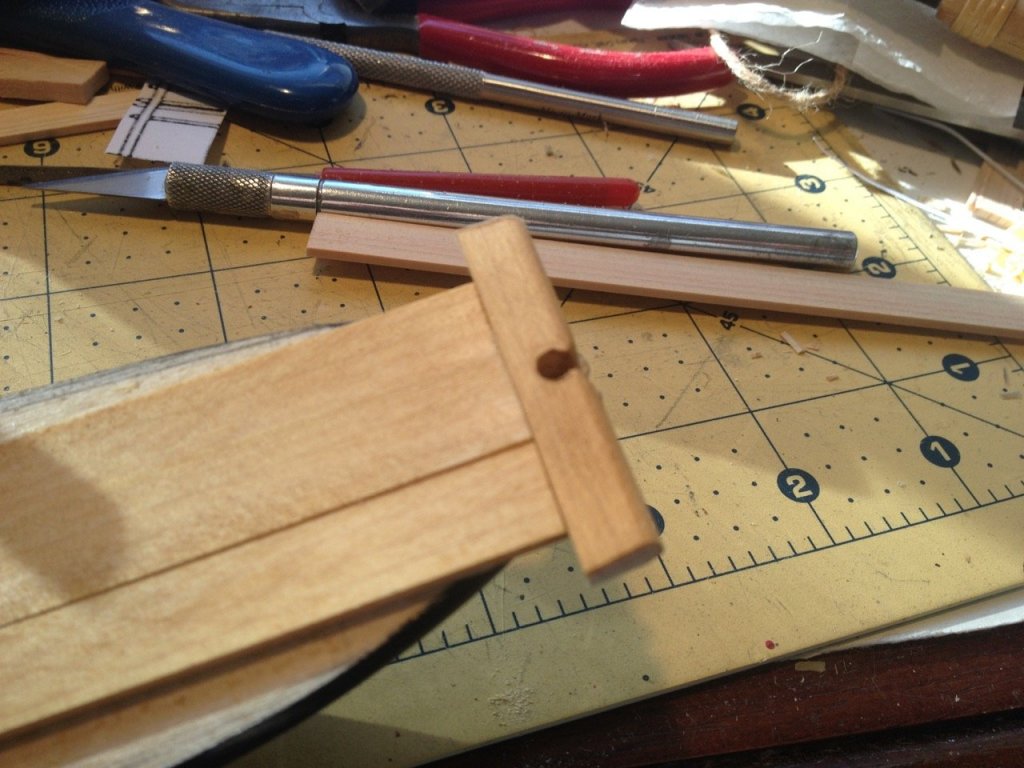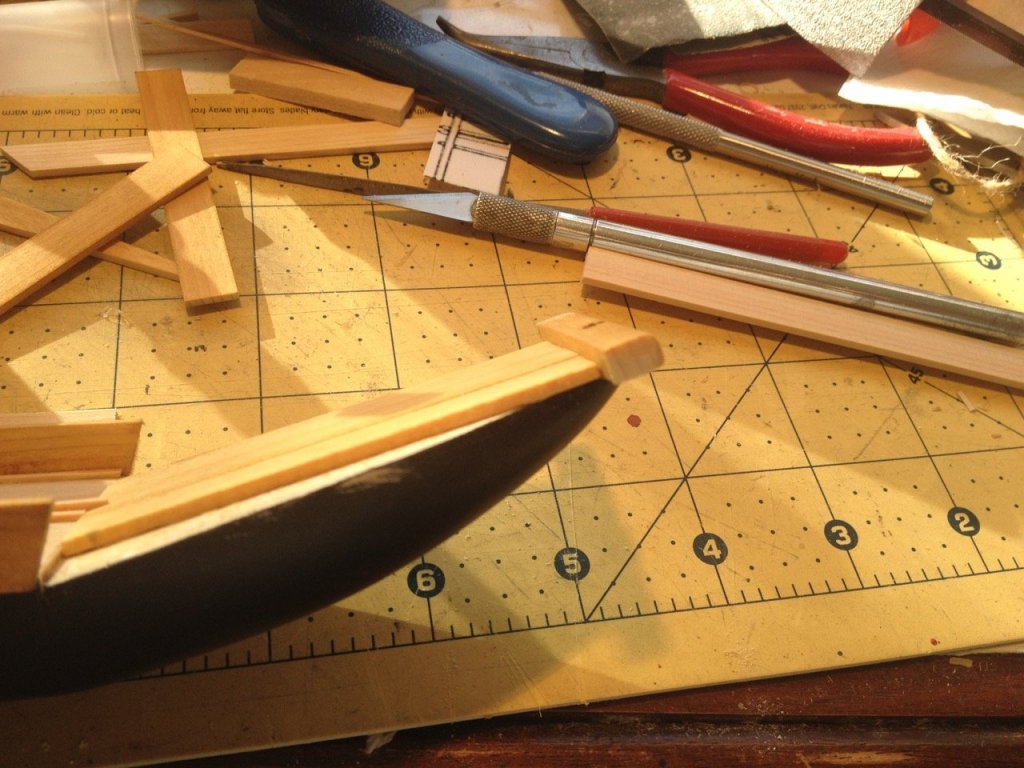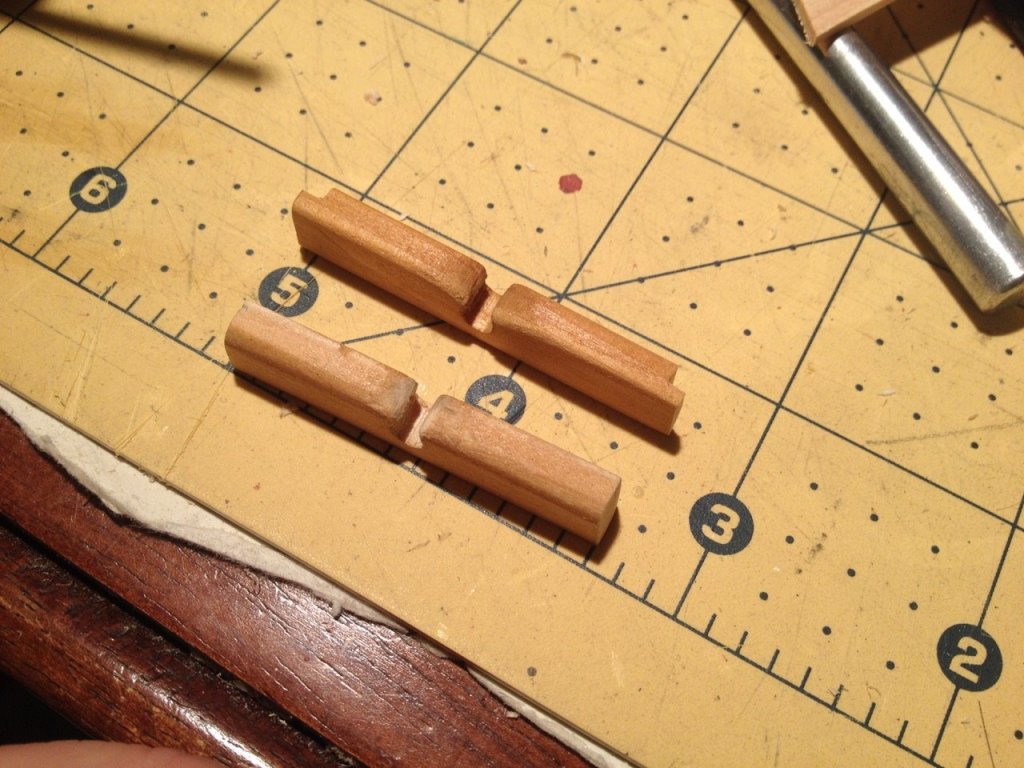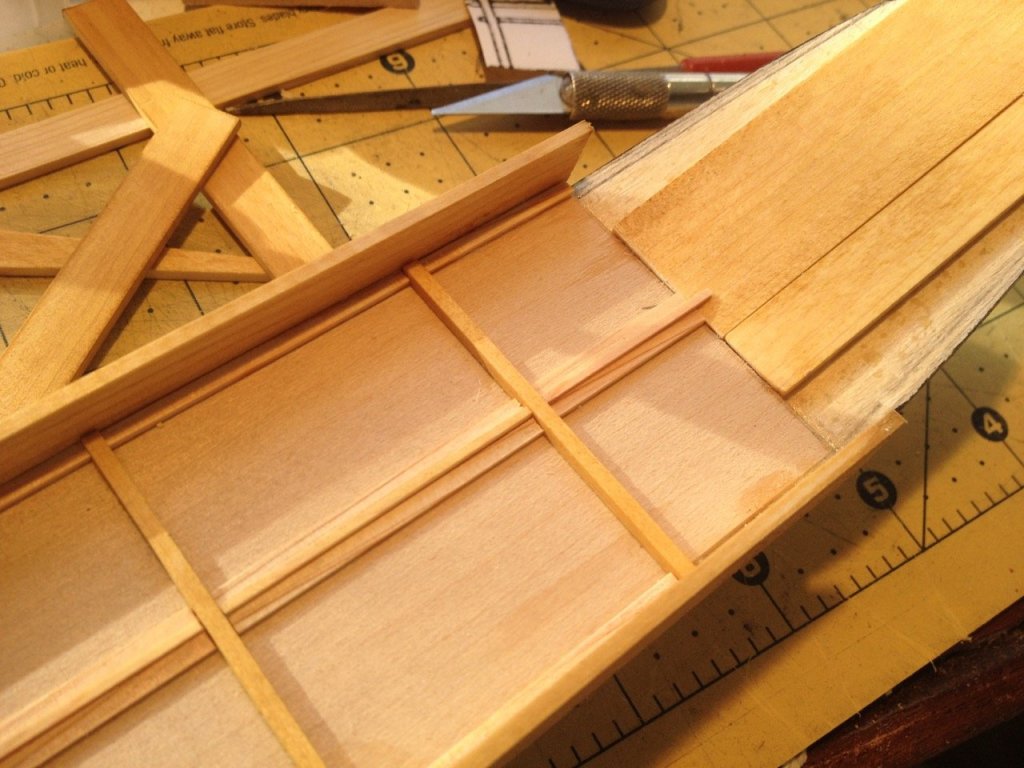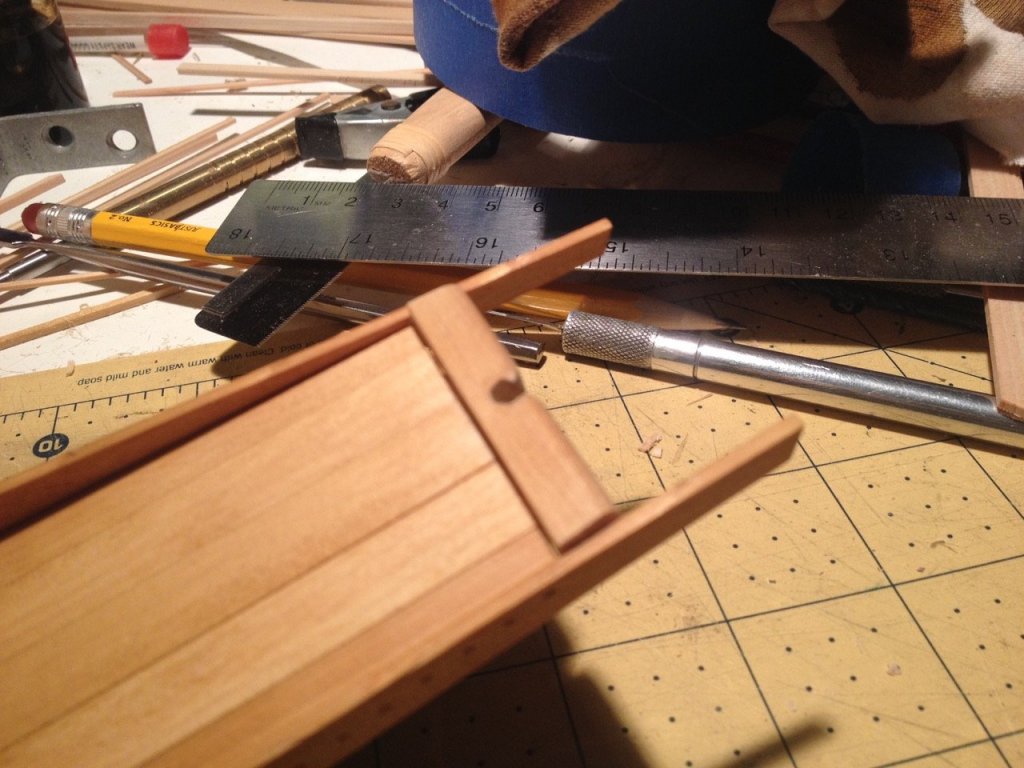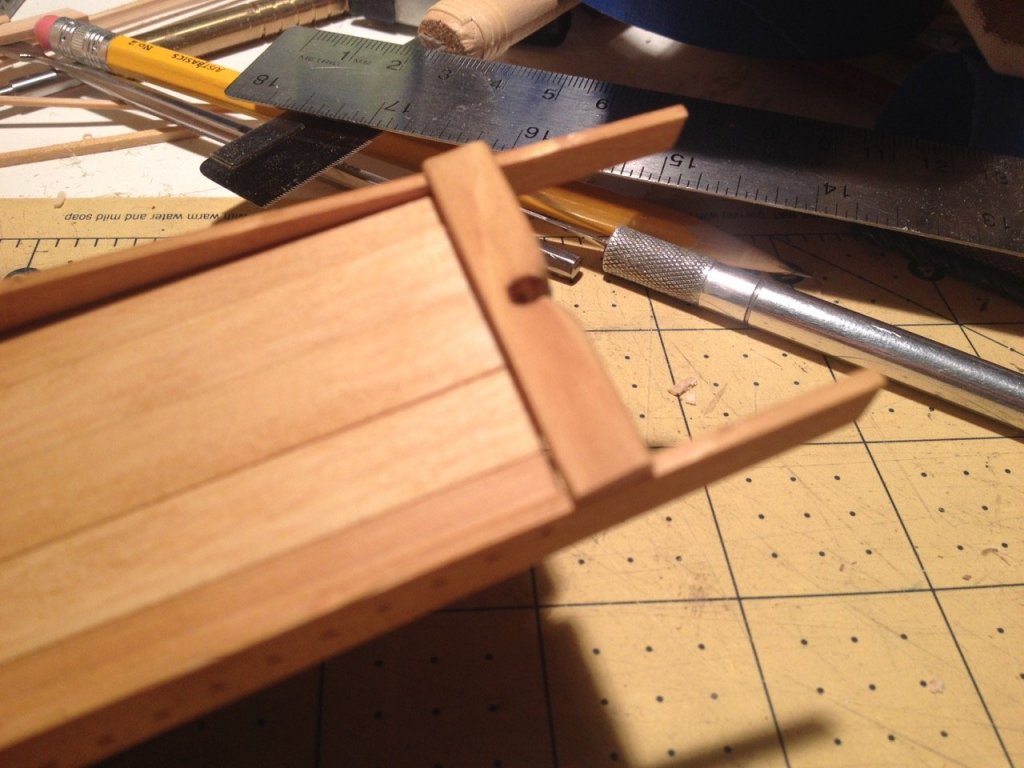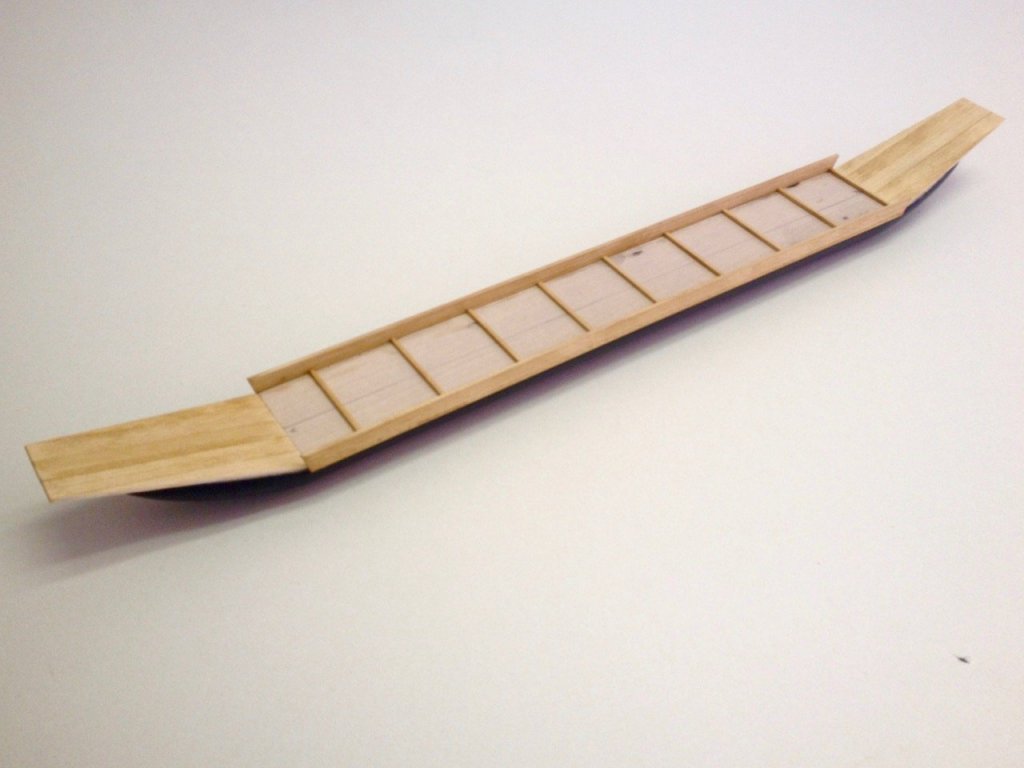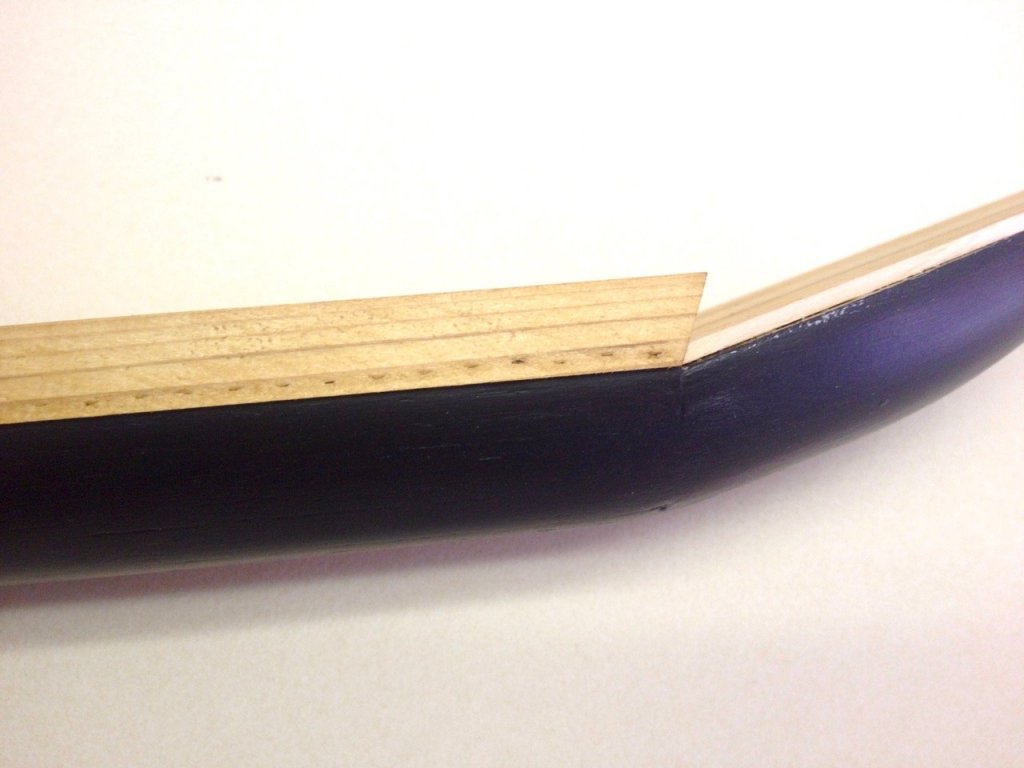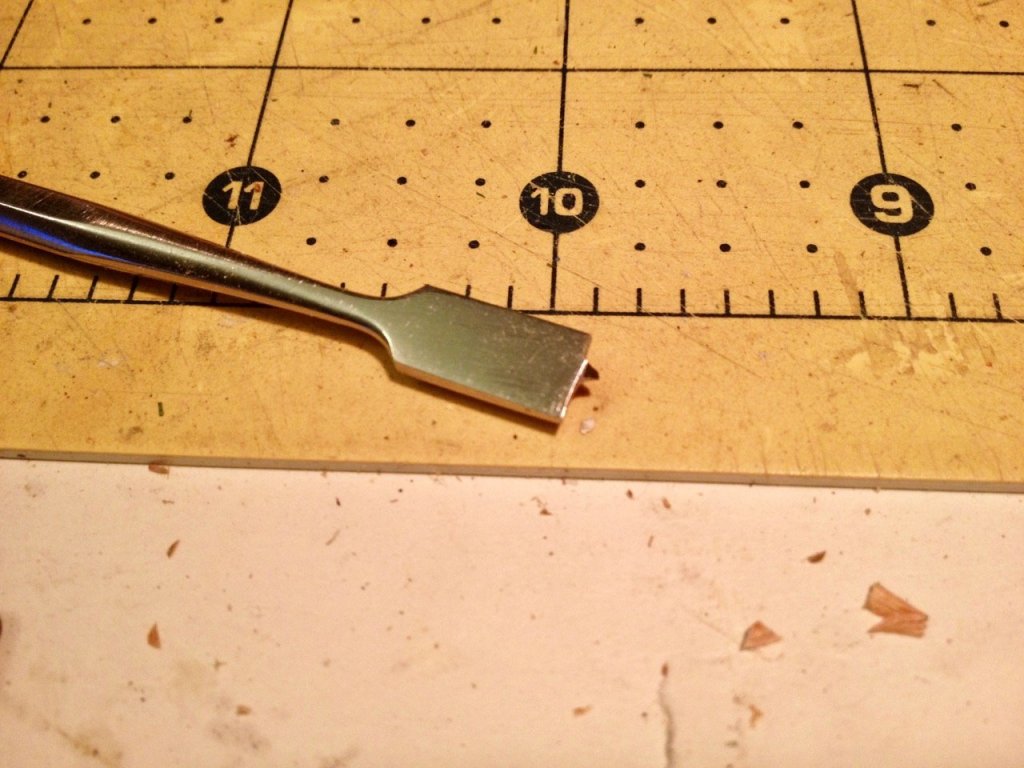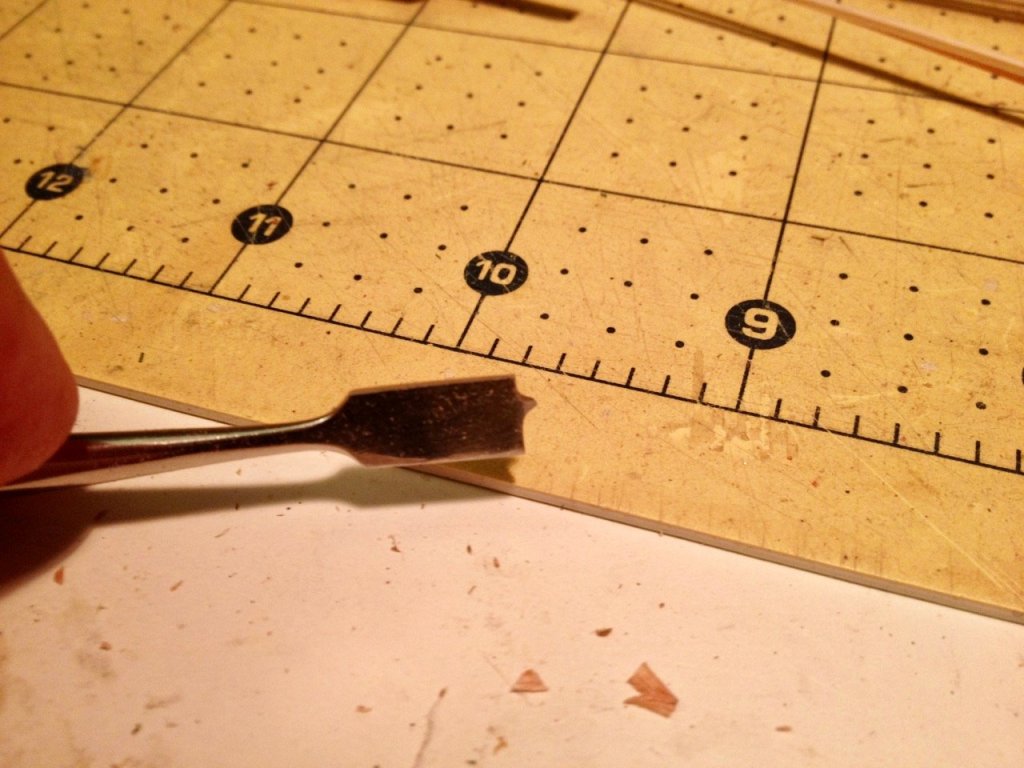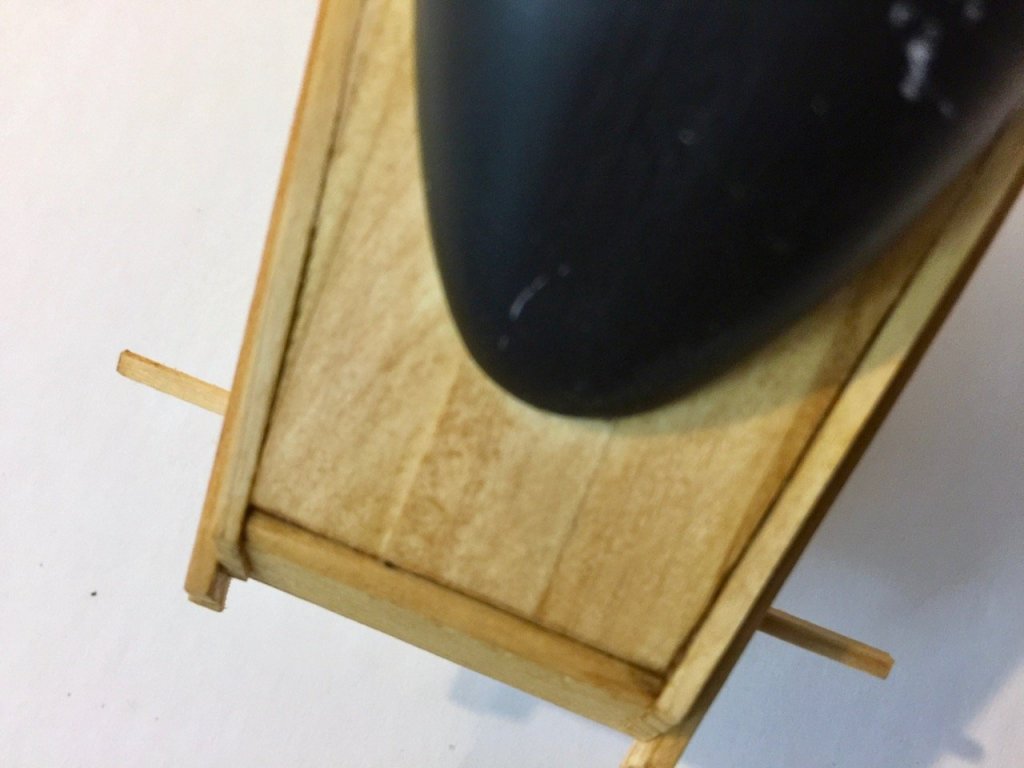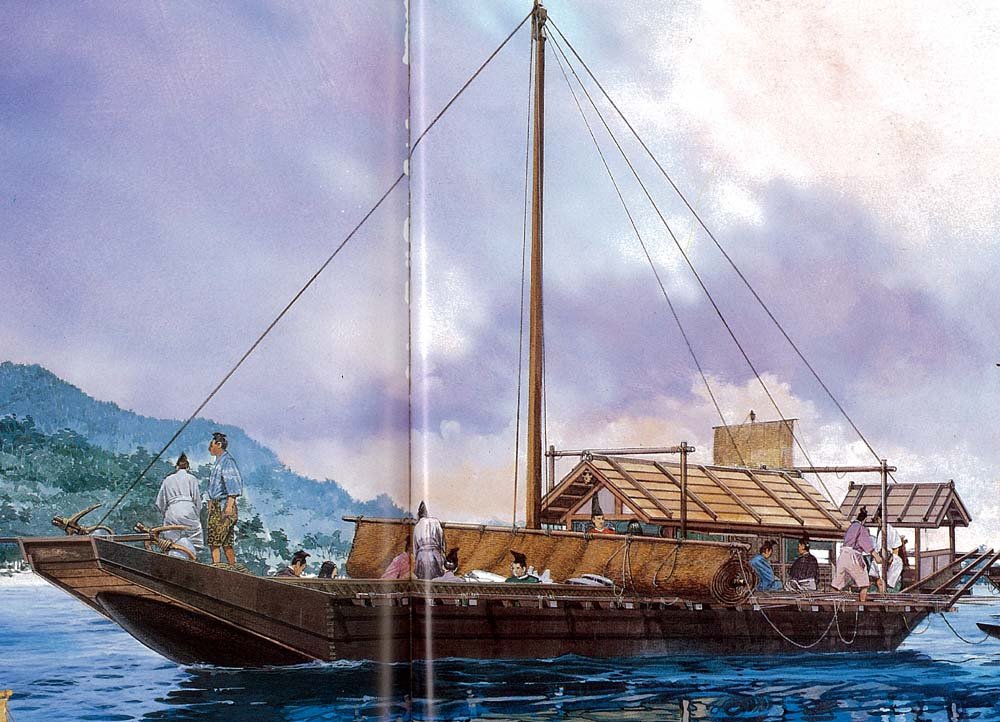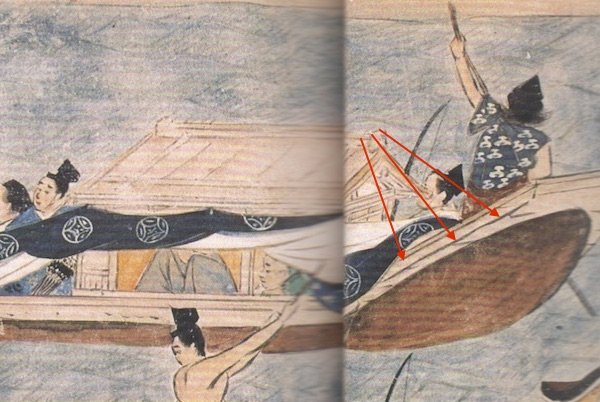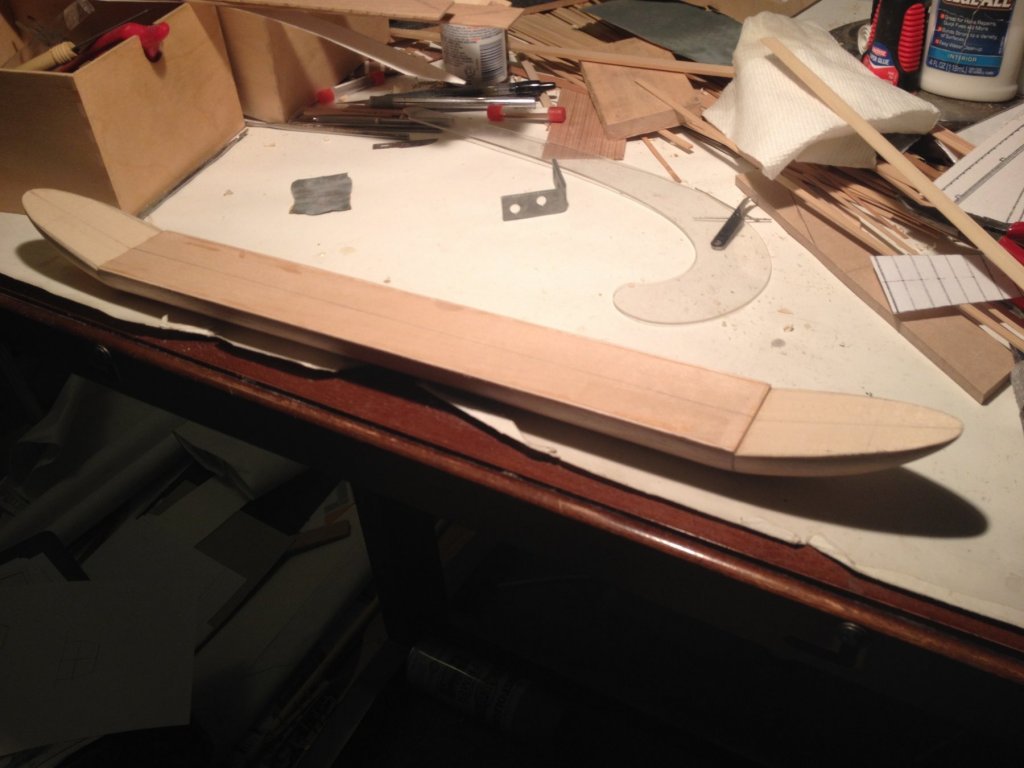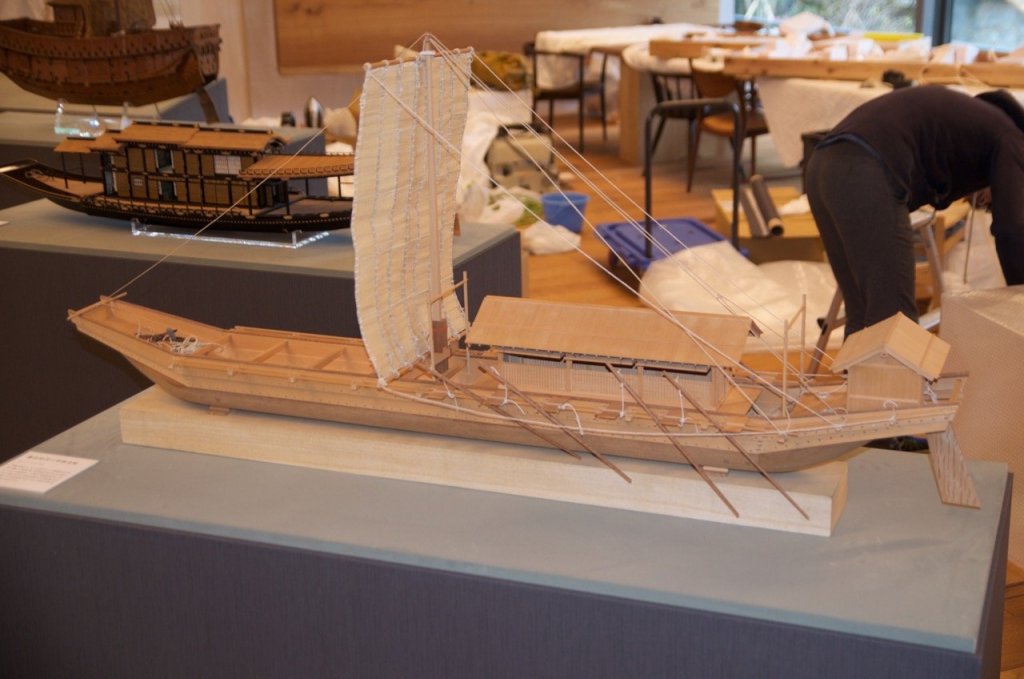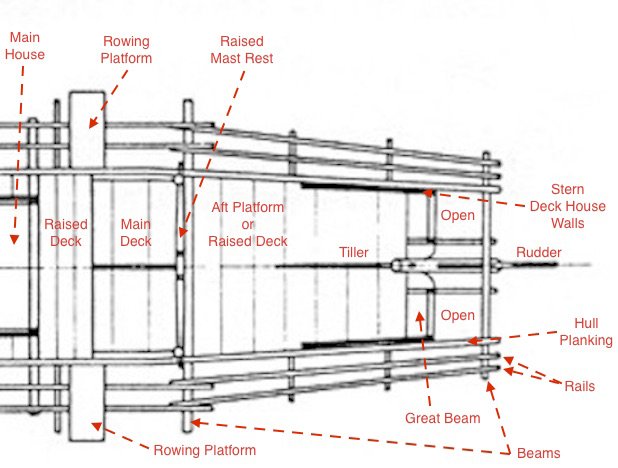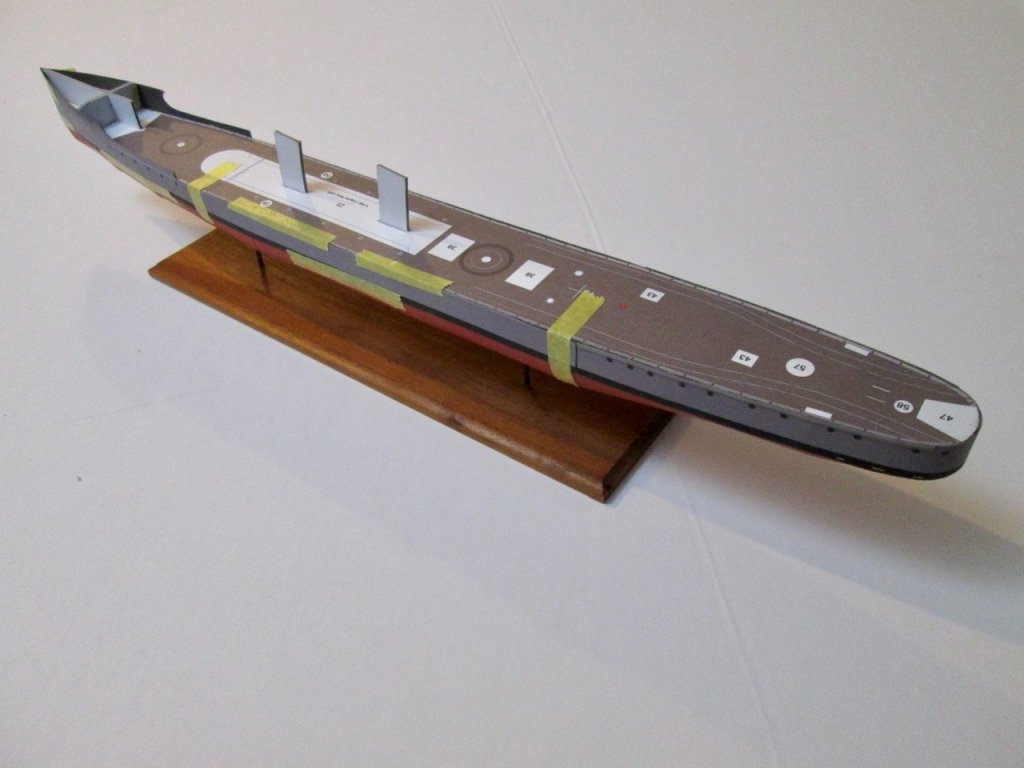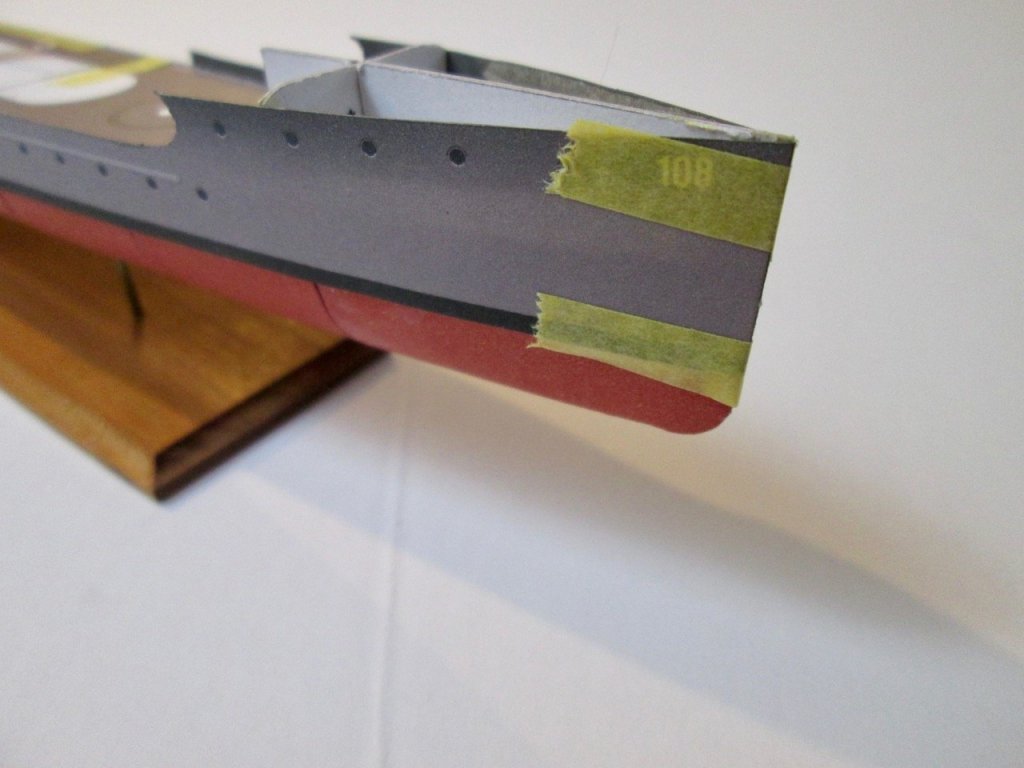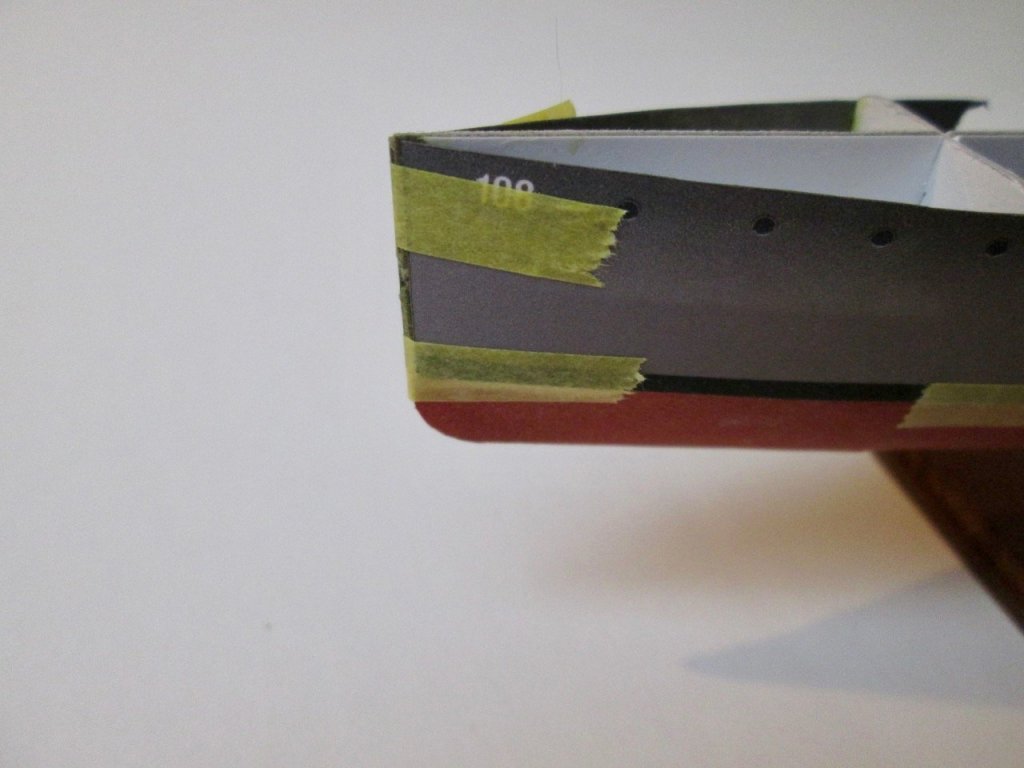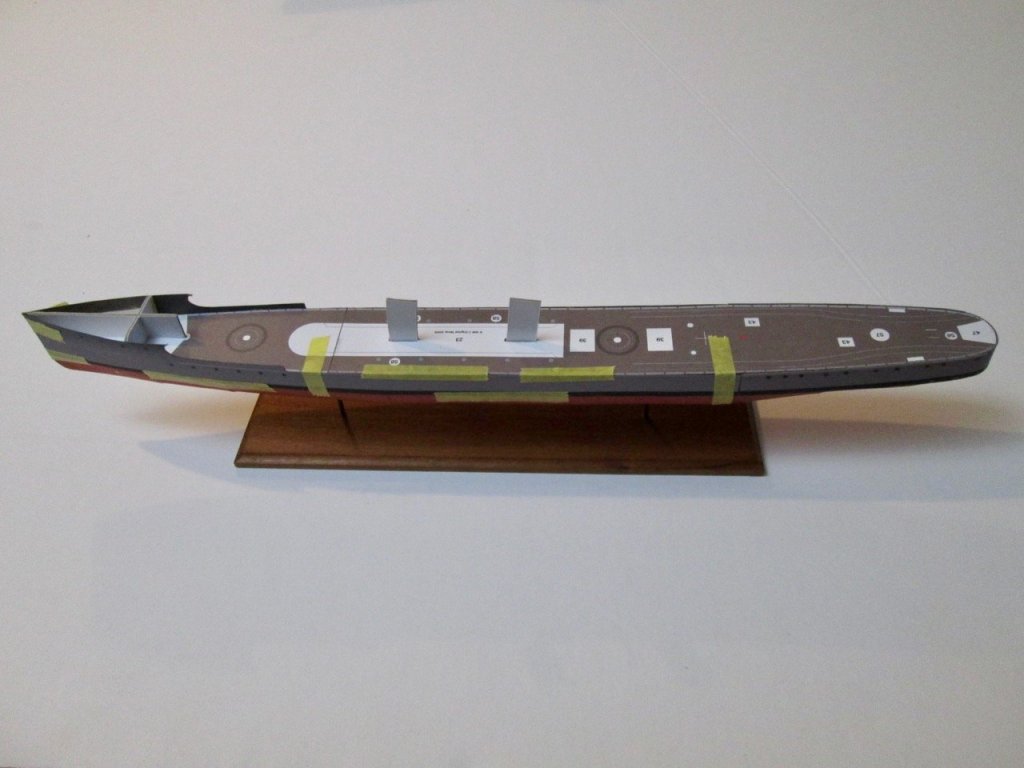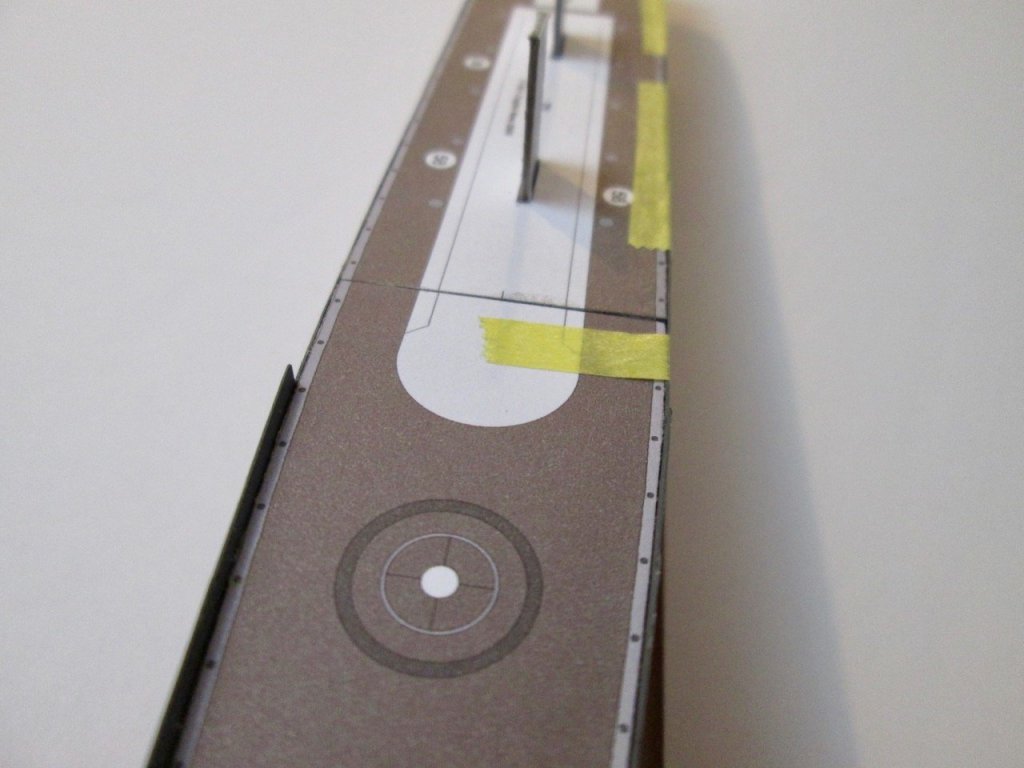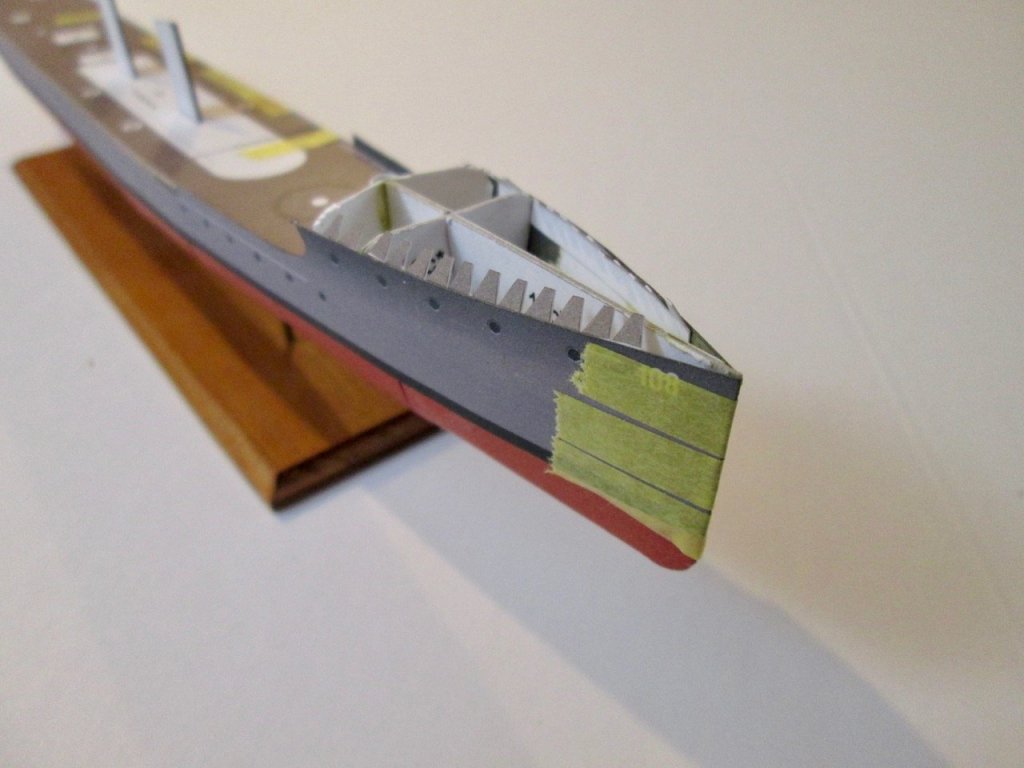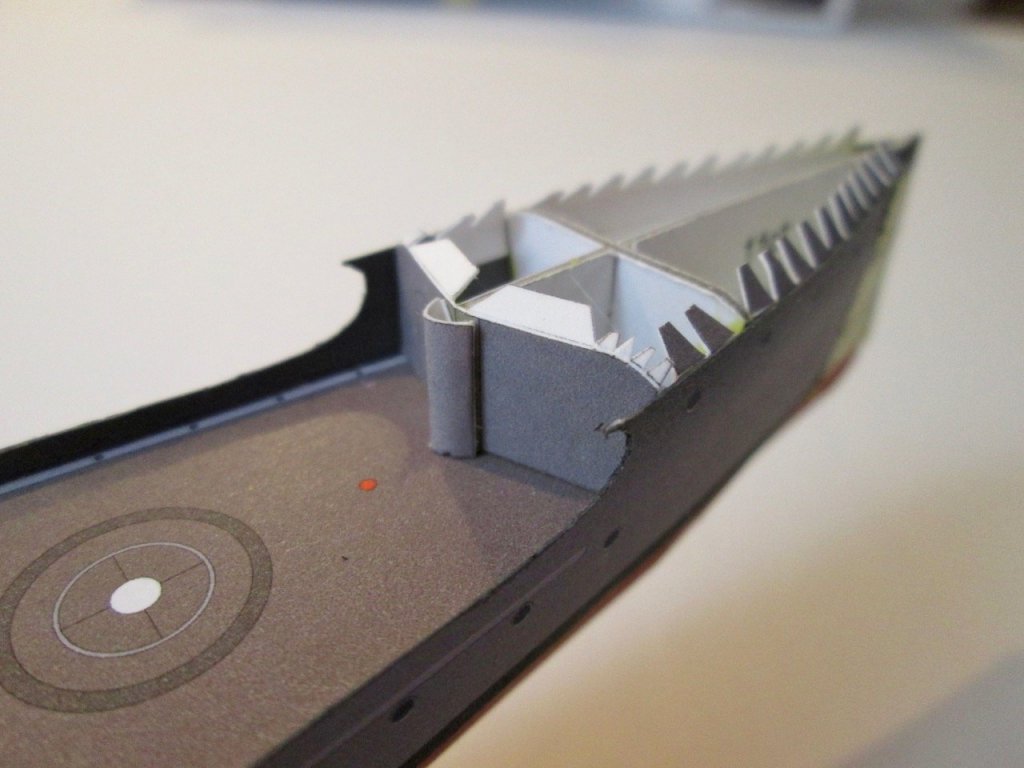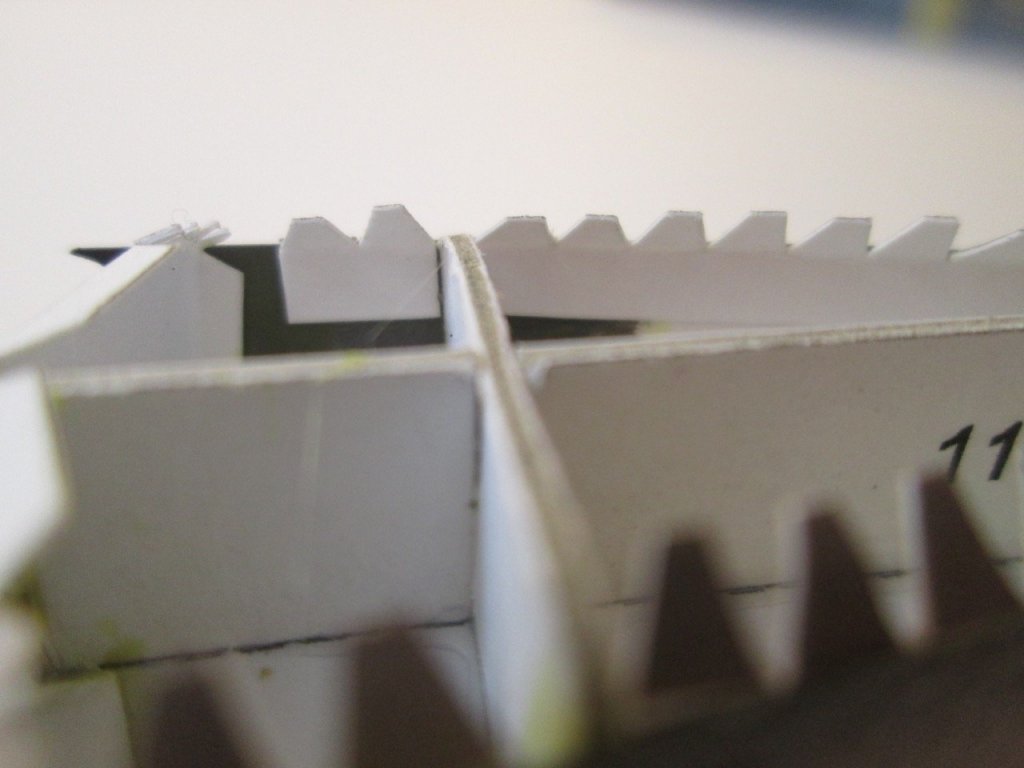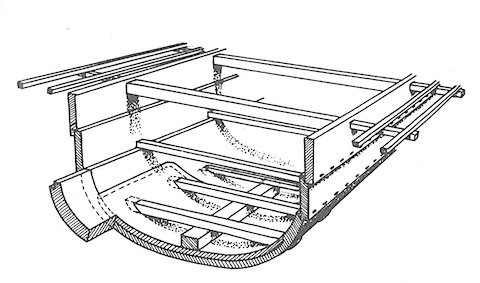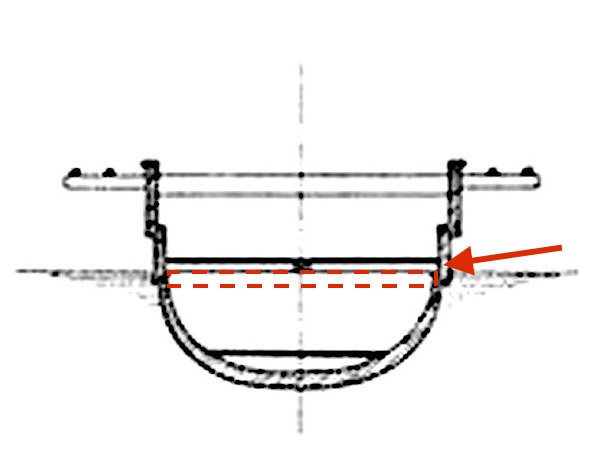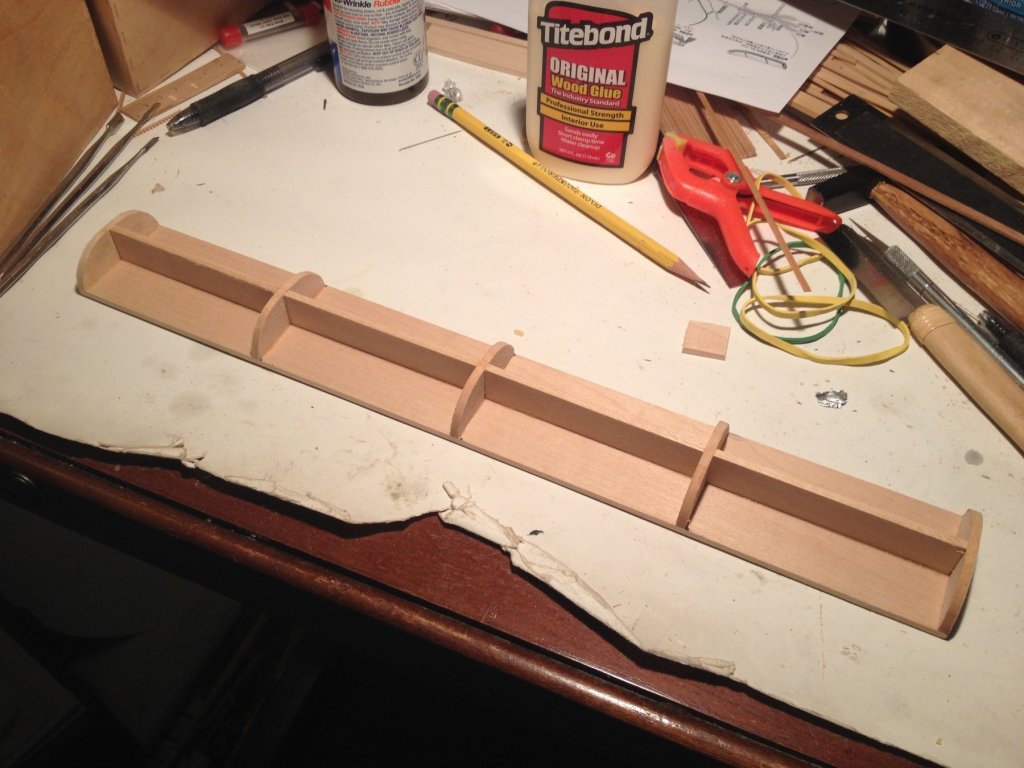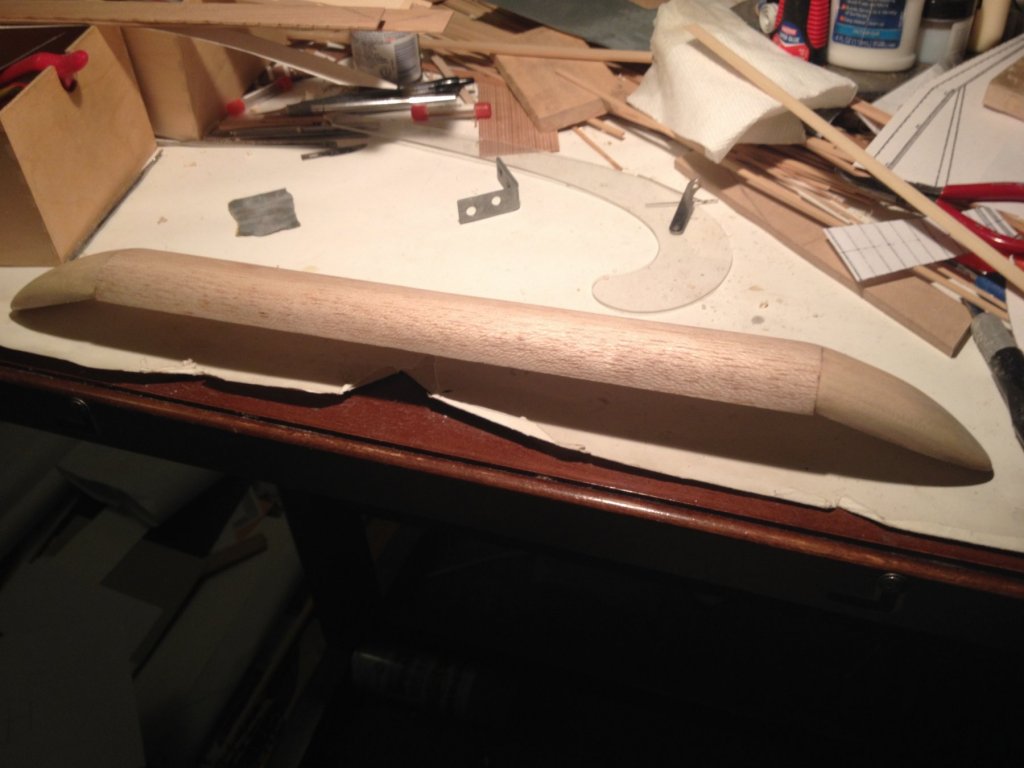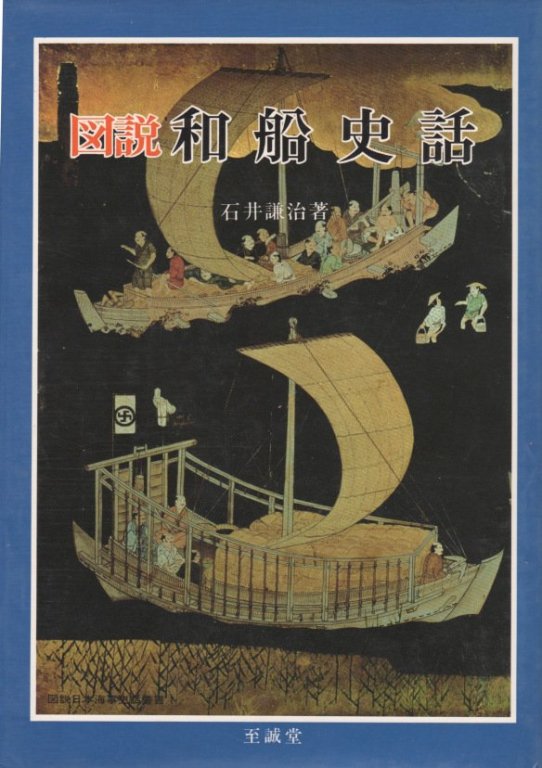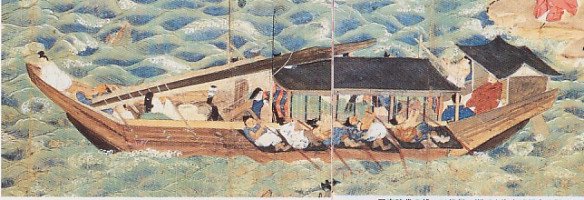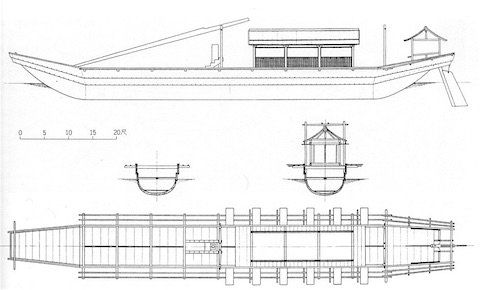-
Posts
1,772 -
Joined
-
Last visited
Content Type
Profiles
Forums
Gallery
Events
Everything posted by catopower
-
The completion of the first of the hull planking gave me a little more confidence to press ahead on the model. There is still much that is unknown at this point, but I’m hoping that some of those details will work themselves out over time. I made platforms at each end of the hull, but realized that the stern platform does not extend all the way to the end of the hull planking. It should stop short, forming something of a “well” for the rudder. In addition, there is the matter of the “great beam”. This is a feature that exists on every type of Japanese boat I’ve seen which has a rudder. There are many regional terms for parts of boats, but this one seems to be universally referred to as the Ootoko (Oh-toko). This is generally the heaviest beam on the ship, and it is notched for the rudder post to pass through. Since the rudders on traditional Japanese watercraft didn’t use gudgeons and pintles, this beam provided the leverage needed holding the rudder against waves, and allowing large rudders to act as keels when under sail. I initially made an otoko and mounted it into place, but later realized that it really needed to be notched to better fit the hull planking. Also, because the ootoko appears to be directly over the aft hull section (the carved block), I found it necessary to notch the end of the carved block. I don’t know that this would be correct, but it was necessary for the way I built this model. While working on the ootoko, I also decided to add the centerline beams for the deck. Based on work I’d done on other Japanese traditional boat models, I knew that the beam had to be cut into sections and fastened between the transverse beams. Also, the centerline beams had to have ledges onto which the deck planks would rest. Similarly, I needed to add a ledge around the edge of the hull. These were all made with 1mm thick hinoki. After I laid out these remaining deck beams, I went back and added the first hull planks at each of the ends of the ship. That's when I discovered that I needed to modify the ootoko. In general, I was very happy with the ootoko I originally made, but it just needed to be better, so I made a second one. The second one was longer and notched so that it fit over the first hull planks. Apologies for the blurry photography. Hopefully, you get the idea. Note how the mortises on the hull planks of the stern platform rise up, as they would have to have been nailed to the deck planks here.
-
The next item to deal with is the main deck. To begin with, I installed beams directly on the hull. These are 2mm square stock hinoki wood. Of course, the real vessel would have a hollowed out hull, but this works out just fine. Most references I could find seem to suggest that beams on Japanese boats are lined up with those above or below them. This makes sense as you want to be able to load cargo without having to deal with beams getting in the way. So, beam placement was easy. With the beams in place, I measured out the spacing for the planks and cut some 1mm thick hinoki strips that I had on hand. They had to be trimmed slightly so that an even number would fit between each beam. In the meantime, I was anxious to get to the hull planking, so I cut some strip stock to fit. As the planks are simple straight pieces, I could use the plans as a direct pattern. The main reason I was anxious to work on the hull planks was to try out a method of simulating the mortises in the wood for the edge-fastening nails. Some time ago, someone gave me a set of stainless steel chisels that I found to be absolutely useless for anything I tried to use them for. Somewhere along the line, I got the idea that I could grind them down to something I could actually use. I decided to buy myself a cheap little bench top grinder, and I made a tool for making mortises in the soft hinoki wood. By pressing the tool lightly into the wood, a rectangular impression could be made. Of course, at this scale, it’s really more of a small slot in the wood. I had originally attempted to grind the “tooth” so that it was centered. That obviously didn’t happen. Then, I realized that I could work this to my advantage. The distance from one edge to the “tooth” was about the spacing I wanted between mortises. So, I used the width of the tool as a visual guide for spacing the mortises. On the real boat, mortises would be cut in the wood and a pilot hole would be made to line up with a similar pilot hole in the edge of the log hull. Then, flat iron nails would be pounded into place. It’s possible that these were made to drive all the way through the log hull, where they might have then bent over and pounded into the wood on the inside of the hull to give them a more secured hold, but I have no evidence of this. In the case of my model, it doesn’t matter, as the inside is not visible, and the presence of the nailing is only represented by the mortises made with the new tool which, by the way, made short work of it.
-
Hi jct, yeah, Shipyard has changed their online store policies a couple times. Roger at Ages of Sail doesn't want to carry more fittings than he already does, so he hasn't been interested in carrying the paper blocks from Shipyard. Paper ship models are still a niche market in a niche market (ship models) in the US, and Shipyard doesn't really understand why Ages of Sail isn't selling more stuff. I think they may be doing this on purpose to get Ages of Sail to buy more stuff and carry the blocks. But, that's just my theory. All i I know is that when Roger put in an order, he gets maybe $8000 worth of product (retail value) at a time. They probably really like that and so they keep bugging him to order. They even bug me about it now, since I help out Ages of Sail with some things. Long winded way to say, I don't know. Might help if people wrote to Ages of Sail asking them to carry the paper blocks. You can also do what I did and just use wooden blocks. Or, if you really want paper, check Cornwall. I think they started selling some Shipyard stuff.
-
Mark, I just got a verification from someone who handles Amati's social media that the offices are closed until the beginning of September, though he said someone might be there a few days earlier. So, it might be a while before you can get any help on this. I did send a message to them about the PE sheet. But, it will probably go unread until then.
-
Hi Kurt, Sounds like you've got it pretty well covered. The clinker planking is already laser cut and I doubt that you'll find it difficult at all. I built Shipyard's HMS Alert paper model, which had clinker planks pre-designed in a similar fashion and found it to be quite easy. Much easier, in fact, than carvel-built planking. The Le Cerf monograph is great, I have a copy myself, but it just makes me want to try to scratch build the thing! I love how the deck in the Dusek kit is already laser cut for you in pear wood so that the planks follow the curve of the hull. Not only does it simplify a difficult to build feature, it makes short work of the deck planking too. I suspect that between the laser-cut deck, and laser-cut clinker planking, you will find this to be a very quick build.
-
Hi Mich, you know Amati's a sponsor of MSW, so you can just click on their banner on the front page and go to "Where we are" under their Contacts tab, that has the phone and email. But, you said you contacted their distributor here and didn't get a positive response, do you mean Ages of Sail? And what wasn't a positive response? I help out Ages of Sail with various things, so I can ask about it. Normally they can order the entire PE set as a special order, but obviously, you just need the missing sheet. The only issue I see might be if the sheets have changed. Usually, things can be special ordered, but it can take a really long time. I'll ask about this.
-
Hi Kurt, Funny you should mention it. I have the kit right here as I was going to do a little slide show or video of the contents of the kit for Ages of Sail, which carries the kit. I think it's oddly overlooked by the general ship modeling community. The standard kit, like other Dusek kits, uses resin castings for the cannons, and that's the only downside I see to it, as I prefer nicely turned brass. Probably something Chuck sells might work. What I really love about the kit is that it's one of the few non-Viking ship model kits that features clinker built planking. I've been planning on taking some photos and I can post them here for you in the next couple days.
-
My apologies for lack of intermediate-step photos. I got a bit carried away with progress, so the photos jump ahead a bit as I describe details of the construction process. As I mentioned earlier, I'm using hinoki, Japanese cypress, and the American equivalent of hinoki, Port Orford cedar. Again, I'll just be referring to it all as hinoki as the two woods are so similar in properties, including the scent. Oh, one correction. I was mistaken about the location of Bear Creek Lumber. I got it mixed up with a place called LnL Lumber Outlet in Oregon, which I first contacted. This is the place that's located in the area where Port Orford cedar grows. Bear Creek Lumber is actually in Washington state. I think I got the two places mixed up at the time and ordered my wood from Bear Creek Lumber. Next time I buy Port Orford cedar, I'll maybe do it when I visit my sister up north and detour to the Oregon coast and pick it up in person. Because hinoki is very light in color, I am dyeing the wood using a product called TransTint, which I thin with denatured alcohol. I just mixed a few of the dye colors by eye to get a more aged wood color. The stuff is not cheap at $25 a bottle, but it goes a long way. I bought mine at the local Rockler Woodworking store. Nice this is that this can be applied to the parts before assembly, as it doesn't interfere with glues. The first thing I did after the lower hull was done was paint it using artist's acrylics. This entire portion of the hull will be painted black, and will be the only paint on the model, so it made sense to do it before adding other wood to it. Somewhere along the line, I realized I had created a couple small dents in the soft basswood sheathing of the main hull. A pin prick through the paint layer and a drop of water swelled the wood are of the dent right up and back into shape, so all is well. The next step was to create the trapezoidal platforms at each end of the vessel. Some images of paintings I referenced show similar boats with these planks running horizontally. I ran them lengthwise, thinking the planks might hold up better against any waves hitting them. Also, if the planks ran cross-wise, I would think it might add some awkwardness to the construction of that platform. In this close-up image, the arrows point to the planking I'm referring to. You can see that these run horizontally. However, this is a much smaller boat and I'm sure it was only used on rivers. The next image is from a modern painting, so I don't necessarily take the details for fact. But, it is a useful interpretation. I like in particular how it shows the straw mat sail, which is too unwieldy to actually furl, so it has to be rolled up instead, though I don't know if it would be quite as bulky as depicted here. So, the planks of these platforms must have been fastened down to the bow hull section, presumably by nailing. It would be interesting to learn how this was actually done, as those very end planks in the image above couldn't be fastened into place without the hull planks being there. Or those planks could have been edge fastened together. Or perhaps the platforms were nailed together to those lower hull planks first, and then the whole assembly was put into place. It's all speculation and I doubt we'll ever know for sure. For these platforms, I cut some hinoki sheet into strips 1mm x 12mm wide. For the deck planking, I matched the measurements from the drawing, and will be using 1mm x 8mm planks. These come out to about 16” wide boards in full size. Seems wide, but 12th and 13th century Japan would certainly have the trees for it. Here's the underside of the bow platform on the umibune model. Again, I apologize because I didn't take photos of the platform at the time of construction, so I had to take a late stage photo. The hull paint job will get a touch up later. At this stage, were I to build the model again, I'd probably just run all the planks side-to-side to match the paintings. The planks are pretty well hidden, and even if this arrangement might be stronger (even that assumption is questionable), if the swells were high enough to be hitting this platform with any force, this boat was probably in trouble.
-
Some interesting background… For those of you that don’t know, this boat is officially described as a Kamakura period boat, and that was the period from 1185 to 1333. In the West, this was the time of the Crusades, King Richard (Robin Hood), etc. In Japan, the period was marked by the end of the Gempai War of the late Heian (Hey-on) period between the Heike and the Genji (Taira and Minamoto clans). The last battle between these clans was a great sea battle called the Battle of Dan-no-Ura (don-no-ooruh). This is the largest Samurai sea battle in Japan’s history and involved an estimated 1300 ships, though most of these were probably small for what we would call a ship. For more detail on this, I recommend reading the Wikipedia entry. For now, let’s just say that the Genji (Minamoto) eliminated the Heike (Taira), and began the Kamakura period with the establishment of a military government and Japan’s first Shogun. The Kamakura period saw the emergence of the Samurai class, the firm establishment of feudalism, and the rise of Buddhism. It was also during this time that Japan fought off two invasion attempts by the Mongols, with the help of typhoons, which destroyed the invading fleets. This is the origin of the Japanese term “Divine Wind” or Kamikaze. Model Thoughts Up to this point, the model is made from common domestic modeling making woods of basswood and a little balsa. For the rest of the model, I plan to use an aromatic Japanese cypress, called hinoki. However, it’s really hard to get here in the U.S. I have a small supply of hinoki strip woods that I purchased from Japan, which I can use for much of this small model. For larger pieces, it turns out that there is a domestic wood that is almost identical to hinoki called Port Orford cedar. It’s also a bit hard to get, though boards can be purchased from some sources. I bought some from Bear Creek Lumber, which is located in the area where the stuff still grows. The stuff is so similar to hinoki, that it might as well be called hinoki, and that’s what I’ll use for the rest of this build.
-
Thanks ragove. I'm just following Chris's tutorial, so I imagine that you'd far more useful info on his build as well as Danny's Amatsukaze build. But, it's nice to know some builders find useful info here. Danny, Jan, for this model, I've just been following Chris's blog, so I went and got some card stock from the local copy place, where I could buy it by the 8-1/2 x 11" sheet. I don't remember the weight of the paper, but I measured it and it's about 0.25mm thick. Seems fine for such a small model as the bulkheads are maybe an inch apart. I could see the advantage of heavier card stock on a larger model. Danny, thanks for the advice on GPM. I've actually ordered some card stock from them about a year or so ago when I was working on my HMS Alert kit, and still have a healthy supply. On this model, I've only needed a small amount for the decks and skeleton. That's the other thing that's nice about building a paper model of this small size – a little material goes a long way.
- 38 replies
-
- digital navy
- v108
-
(and 2 more)
Tagged with:
-
Hi Bob, thanks for the support. I suspect you'll be passing me up and I'll start following YOUR blog soon. Do yourself a favor and record the exact printer settings you used. Later, if you need to reprint a part, it will save a little frustration. I thought I knew what settings I used, but when I reprinted a sheet, the color hues came out differently. I'm sure it was user error and not some printer issue. Danny, thanks for your comments. I figured the PE railings might not match up with the printed spots for the stanchions. I'll definitely be looking at what you did there on the Amatsukaze. Yeah, I probably should have cut separate connector tabs for the aft forecastle bulkhead, but I don't mind learning a little bit the hard way! I think this section may be okay. I just need to drill, paint and mount a support stanchion under the aft end of that forecastle deck. These models are pretty neat. I do like being able to print the parts, as you have a little more control over the print quality, plus an endless supply of replacement/repair parts.
- 38 replies
-
- digital navy
- v108
-
(and 2 more)
Tagged with:
-
Here's another pic of the hull that I didn't post last time. My plan is to paint this portion of the hull black using Liquitex acrylics. Because the balsa sheet of the main hull is grainy and porous, I'm using a bit of wood conditioner on it first and giving it a light sanding. Deck planking will sit directly on top of this assembly, so you can see that there is no need for a carved out hull. Had this been a model of a smaller boat, I would have had to carve it out. The next step will be to add the trapezoidal-shaped platforms that will fit on top of the end sections of the hull at the bow and stern. These platforms look pretty straight forward and will have to be pieced together from planks, though it took some study of the stern platform (right side of drawing) to understand what's going on there. Below is a breakdown of some of the elements of that stern platform. Sorry the image is a little fuzzy as I had to blow it up to fit the text in there. And finally, here's an image of a museum model that was on display at the tool museum in Kobe while Douglas Brooks was building a boat there. The image is courtesy of Douglas Brooks. You can see a lot of details in this model that are hard to see in the 3-view drawing. More on the end platforms next time. Edit: In the background of this last photo, you can see two other models. In the far background is an Atakebune (ah-ta-kay-boo-nay), which was a warship from the Warring States period, roughly from the mid-15th century through the end of the 17th century. These were the largest of the Japanese warships. Something akin to their battleships. They were big, lumbering ships with a small castle-like structure mounted atop. The other vessel in the mid background on the left is a Kawagozabune (kah-wa-go-za-boo-nay), something of a highly ornate riverboat/yacht used by nobility as a symbol of their prowess. This would have been seen primarily on the rivers connecting Osaka and Kyoto. I'm not sure how far back these yachts date back. I'm guessing that this one in particular is probably from the Tokugawa period (1603-1868) as the period was peaceful enough that this type of boat could be safely used, and the hull is of a built-up, structured hull. But, there were similar types of river transports, not so well decorated, that had hulls similar to my Umibune.
-
Here's a bit of an update. I've been working on the torpedo boat now and again and tonight I took a break from another project to get some things done on the hull. I finished adding the main hull skins. Because my model curves up just slightly at the ends, it took a little extra work to get this part of the hull done. Overall, things went just fine. I used contact cement at this stage. The main issue I had was that even though I centered the stern piece as perfectly as I could, it came forward slightly on one side of the ship. As a result, the starboard side looks fine at the bow, but the port side comes up a little short. I'll work on cleaning up the bow next, but it's not all that noticeable except under close scrutiny. While I was at it, I also shortened the brass rods that hold the ship up on its stand. I think it looks much more natural now. I don't know if I mentioned it before, but the yellow tape is Tamiya masking tape. It peels off quite cleanly and doesn't mar the printed paper at all. The final thing I did was to add the connecting pieces to the forecastle. I think Chris mentioned that there is a minor flaw in the kit in that this toothed connecting strip has to be cut in order to fit on both sides of the forecastle's internal bulkhead. You'll also note that I added the aft bulkhead of the forecastle. That worked out quite nicely, though, like the toothed connecting pieces for the forecastle deck, the bottom connecting tabs on the bulkhead needed to be cut to allow the bulkhead to bend in the center and fit around the centerline bulkhead of the forecastle. I have also bent the forecastle deck edges down and I'll be looking over Chris's tutorial to see that I don't miss anything at this stage of construction.
- 38 replies
-
- digital navy
- v108
-
(and 2 more)
Tagged with:
-
There’s a lot of history and background to discuss for the this model, but what’s a build log without the construction of the model itself? If you look at the line drawing I posted at the start, you’ll see that the hull has a semi-circular base to the hull. That’s because these boats were essentially dugouts. It is what Japanese scholars call a semi-structured type, or a junkozosen. It features a dugout log hull with reinforcing beams and the addition of hull planking to increase the ship’s seaworthiness and carrying capacity. You'll notice that the scale is labeled with and 尺 character, which is the symbol for shaku, the Japanese carpenter’s unit of measure, which is almost exactly equal to one foot. This shows our Umibune has a hull cross-section of about 9 feet. The log hull was probably made from the Japanese camphor tree, which is a type of evergreen that’s not particularly tall, but with a trunk that has been known to reach over 20 feet in diameter. A boat this large was built in sections, and the drawing suggests four sections, a shaped bow and stern section that is attached to two dugout log sections fastened end-to-end. I don’t have any information about how the logs were securely fastened end-to-end, but I did find an illustration in one of Professor Ishii's later books that suggests it’s not just a simple joint. Before I could start, I needed to choose the scale for this model. I’d love to have some consistency of scale between my Japanese boat models. But, my models are all over the place here. I have 1/10-scale for my Tosa wasen, 1/24 for the Woody Joe kits of the Hacchoro and Yakatabune, 1/72 for the Higaki Kaisen, 1/20 for the rice field boat, and so on. For small boats, I’m trying to try to stick to a common scale of 1/10, for medium-sized boats, 1/20-scale is okay, and maybe for the largest boats, I’ll shoot for 1/50-scale. For the Kamakura period Umibune, this makes the model just about 2 feet long, which should be a reasonable size for a model on the shelf. I set about scanning and resizing the drawings accordingly. Hull Construction The first issue I came across then, was whether or not I needed to carve out a hull to build this model. For the modeling of a smaller boat, it would certainly have been necessary. But, a boat this size would probably have had a planked deck. Looking at other, later Japanese boats, these planked decks were commonly flush with the transverse beams that you see in the cross section images. In the case of this hull, the planked deck would sit upon the edge of the dugout section of the hull. The same would be true at the bow and stern. This meant that it wasn’t necessary to carve out the hull, I just needed to built a round hull. Also, the main hull has the same cross section all the way down its length, making construction very simple. Since I didn’t have to actual carve out log-shaped pieces, I decided to cheat a bit, and build the model “Western-style.” That is, I made a series of semi-circular bulkheads, shaped to templates I made from the drawing. The bulkheads would be connected together by a single basswood strong-back that would run the length of the main hull. The illustration below shows the section of the strong-back as a broken-outline rectangle. The arrow show the placement of the beams and planks directly on top of the strong-back. I cut five bulkheads out of basswood. The bulkheads are all identical, so the spacing isn’t particularly relevant. I just spaced them out evenly. Now, with a bit more foresight, I would have added some kind of internal keel down the center, even in separate pieces, just so I could drill it for mounting posts. As it was, the bulkheads themselves were fine, but locating them after the hull is constructed adds some complexity to the task. Between the bulkheads, I put in a series of basswood strips that would help support the bulkheads, and would later give me something to drill into for mounting pins, though I probably should have used thicker strips for this reason. In any case, rather than planks, I covered the hull bottom with a single sheet of balsa, which I figured would be flexible enough to wrap around the curve of the bulkheads. This turned out fine, but did require a lot of care during construction, as the balsa crushes or mars easily. But, little dents are also fairly easy to repair as I later found. The ends of the hull were simply shaped basswood blocks. I traced the profiles onto the block, carved away the bulk of the excess wood, and then used the belt sander for the bulk of the shaping. Note that the shape of the ends differs very slightly between bow and stern, as the bow rises a bit more sharply.
-
Ken, Tim, I'm happy to have your company here. As I proceed, let me state for the record that I'm no expert on Japanese traditional boats, nor do I know much about Japanese history. I really just know bits and pieces, and spend a lot of time learning and relearning things. I'm interested in Japanese culture, being half Japanese myself, and spend a fair amount of time and energy making Japanese and Japanese related connections, like with Woody Joe, Douglas Brooks, Thermal Studio (the Tosa wasen kit), The Rope, etc. But, any Japanese ship modeler who has an interest in the subject of Japanese traditional boats, could surpass my knowledge in a heartbeat, just from their ready access to written information, museums, etc. Still, very few Japanese people have much of an interest in the details of things of this nature. I have managed to foster a friendship with a couple Japanese ship modelers. One of them has some knowledge of Japanese boats because he was helping someone outside the country with information on them, and has been helping me out over the past year or so. Only recently did he build what I believe is his first model of a Japanese traditional boat, the Tosa wasen kit from Thermal Studio. So, all of this is really to say that getting information can be very difficult, but if you're interested and have any questions, I'm happy to help in what ways I can.
-
Hi John, you'd think my Japanese would be improving with all this stuff. But, in actuality, it seems to be making me a more confused person... I HAVE, however, gotten quite proficient at scanning and clipping text and using Google Translate, and then sorting through the odd translations. It's a lot like tying ratlines. Don't think about it, it's a long process, you just do it one step at a time...
-
Hi Carl, Douglas Brooks focusses on preserving the information of this last generation of traditional wooden boatbuilders, so it's not the kind of thing he has much information about. He did, however, provide me with a couple nice photos of a museum model that appears to be the same model as on the Nippon Foundation website that I mentioned. The model was part of a display that was set up at the carpentry tools museum in Kobe, Japan, in the Spring last year, where he had a boatbuilding project that people could watch live. I recommend visiting his blog, if you haven't already: http://blog.douglasbrooksboatbuilding.com/2016/03/takenaka-carpentry-tools-museum.html It doesn't have anything to do with my model, but his work is fascinating and very important. Hi Dave, I'll try to keep it interesting – Good to see you around!
-
I thought I'd start a new blog here to show what I have been working on in between my paper model "distraction" projects. This too is something of a distraction project, but it's also part of my on-going study of Japanese traditional watercraft. To date, the Japanese boat models I've done are mostly kits, mostly Edo period (1603-1860), and mostly small boats. This model differs in a lot of ways from the others in that it is from the Kamakura period (1185-1333), is a scratch build, and is a larger boat, nearly 100 feet long. The boat type is old enough, or perhaps obscure enough, that there is no specific term to identify it other than as a Kamakura period large sea boat, or in Japanese, Kamakura jidai no dai umi-bune. Something of a long name, so I'll just refer to it as an Umibune, since the term doesn't really seem to used in other contexts. I got interested in the Umibune (that's oo-me-boo-nay) partly because there are few build plans of Japanese watercraft to be found anywhere. The Japanese don't have a history of recording measurements or detailed drawings of their work. Instead these boats were built by craftsmen who kept their techniques secret and passed their work on to their apprentices. So, the only details we really have are from those who have studied relics, paintings, and other boat designs. In this case, my primary source of information is from the late Professor Kenji Ishii who wrote a few books on the subject, and is pretty well considered the "Father of Japanese Boats". Last year, I located the "bible" of traditional Japanese boat research, Professor Ishii's book, published in 1983. The book has been out of print, though it seems to have been supplanted by a two volume set of smaller books that essentially contain the same information, and is called the Illustrated History of Japanese Traditional Boats. It is written entirely in Japanese, which makes research very challenging – I can't really read much Japanese. But, there is the technology and the determination to overcome such obstacles. In addition, there is a website of the Nippon Foundation Library, which hosts online articles on many subjects. This is actually where I first learned about the Umibune. The site showed a small image of a museum model of an Umibune as part of a small chapter on these boats and their construction. It's in Japanese, but here's a link to the site: https://nippon.zaidan.info/seikabutsu/2000/00200/contents/057.htm While this was an interesting find, at the time I ran across it, it was just one of many subjects I ran across in my research. The fact that it was a boat of the Kamakura period kind of put it out of my view, as I was focussing so much on the Edo period, which took place 300 to 600 years later. It was hard enough to study Edo period boats, and I knew even less about the Kamakura period, so I pretty well set the subject aside. It wasn't until I got a copy of Professor Ishii's work that I started taking a more serious interest. You see, Japanese boats are so different from their Western counterparts, that the simple drawings that I could find were mostly inadequate (or perhaps I was more inadequate) for creating a reasonably accurate model. But, Professor Ishii's book included a 3-view diagram of this particular boat, which was more detail available than for most subjects. Now, if the subject were of a more complex design, this diagram might prove next to worthless for model building purposes. But, I realized that the characteristics of this particular boat design allow me to use the 3-view drawing as a build plan. Now I've actually gotten pretty far along on this model, but I thought I'd take the opportunity to document the work here as best I can, so anyone interested can get an idea of what's been going on. If it inspires or connects me with others interested in Japanese traditional watercraft, so much the better.
-
Thanks David, Nantucket Lightship, nice choice! Now, this doesn't mean I won't mix you guys up. Just that I have less to complain about when I DO mix you two up!
-
Yes, and they make some nice aftermarket products for various paper kits too.
About us
Modelshipworld - Advancing Ship Modeling through Research
SSL Secured
Your security is important for us so this Website is SSL-Secured
NRG Mailing Address
Nautical Research Guild
237 South Lincoln Street
Westmont IL, 60559-1917
Model Ship World ® and the MSW logo are Registered Trademarks, and belong to the Nautical Research Guild (United States Patent and Trademark Office: No. 6,929,264 & No. 6,929,274, registered Dec. 20, 2022)
Helpful Links
About the NRG
If you enjoy building ship models that are historically accurate as well as beautiful, then The Nautical Research Guild (NRG) is just right for you.
The Guild is a non-profit educational organization whose mission is to “Advance Ship Modeling Through Research”. We provide support to our members in their efforts to raise the quality of their model ships.
The Nautical Research Guild has published our world-renowned quarterly magazine, The Nautical Research Journal, since 1955. The pages of the Journal are full of articles by accomplished ship modelers who show you how they create those exquisite details on their models, and by maritime historians who show you the correct details to build. The Journal is available in both print and digital editions. Go to the NRG web site (www.thenrg.org) to download a complimentary digital copy of the Journal. The NRG also publishes plan sets, books and compilations of back issues of the Journal and the former Ships in Scale and Model Ship Builder magazines.

